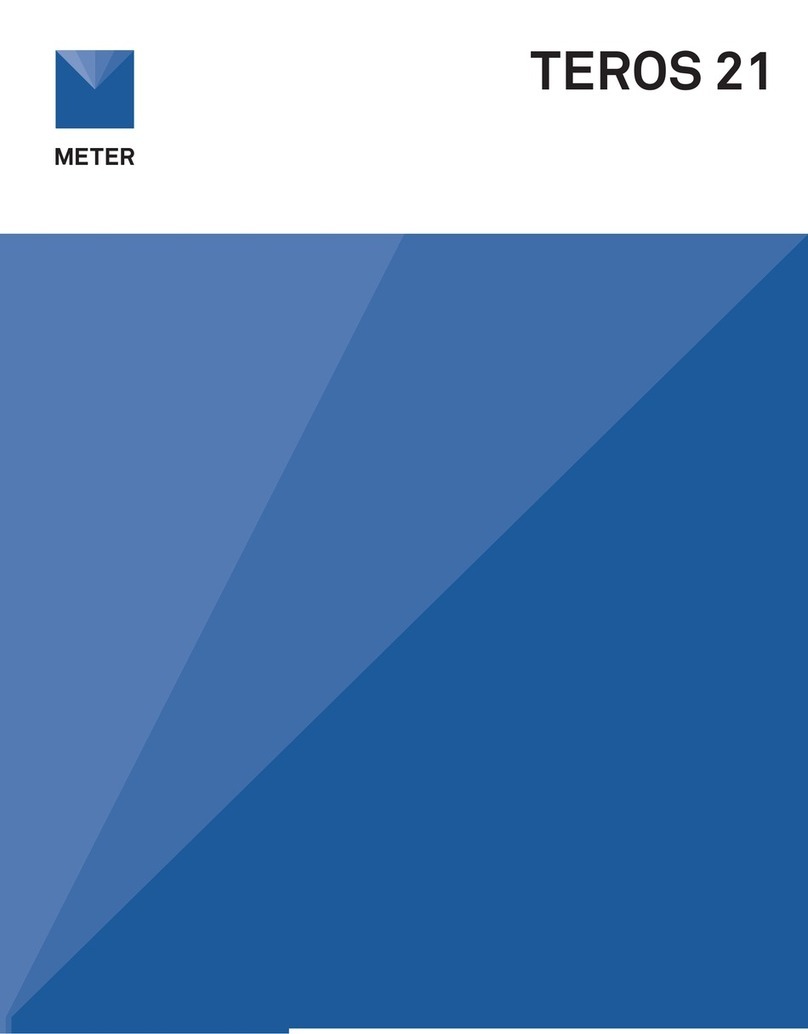METER TEROS 10 User manual

TEROS 10


i
TABLE OF CONTENTS
1. Introduction..............................................................................................1
2. Operation ...................................................................................................2
2.1 Installation.................................................................................................2
2.2 Connecting.................................................................................................7
2.2.1 Connect to METER Data Logger.........................................................7
2.2.2 Connect to a Non-METER Logger ......................................................8
2.3 Interfacing With Data Loggers ....................................................................9
3. System....................................................................................................... 10
3.1 Specifications ..........................................................................................10
3.2 Components.............................................................................................12
3.3 Theory ......................................................................................................13
4. Service....................................................................................................... 14
4.1 Calibrations..............................................................................................14
4.1.1 Mineral Soils ...................................................................................14
4.1.2 Soilless Media.................................................................................14
4.1.3 Apparent Dielectric Permittivity......................................................15
4.2 Troubleshooting........................................................................................15
4.3 Customer Support....................................................................................16
4.4 Terms and Conditions...............................................................................16
Reference....................................................................................................... 17
Index ................................................................................................................. 18
18241-00
6.30.2018

ii

1
TEROS 10
1. INTRODUCTION
Thank you for choosing the TEROS 10 Rugged Soil Moisture sensor.
The TEROS10 sensor is designed to be installed in mineral soils, many types of growing
media, and other porous materials.
This manual guides the customer through the sensor features and applicationsand describes
how to use the sensor successfully.
• Volumetric water content (VWC) measurement
• Soil/substrate water balance
• Irrigation management
Prior to use, verify the TEROS10 arrived in good condition. METER recommends testing the
sensors with the data logging device and software before going to the field.

2
OPERATION
2. OPERATION
Please read all instructions before operating the TEROS10 to ensure it performs to its full
potential.
PRECAUTIONS
METER sensors are built to the highest standards. Misuse, improper protection, or improper
installation may damage the sensor and possibly void the manufacturer’s warranty. Before
integrating the TEROS10 into a system, follow the recommended installation instructions
and have the proper protections in place to safeguard sensors from damage. If installing
sensors in a lightning-prone area with a grounded data logger, see the application note
Lightning surge and grounding practices.
2.1 INSTALLATION
Follow the steps listed in Table 1 to set up the TEROS10 and start collecting data. For more
detailed installation information consult the TEROS Sensors Best Practices Installation Guide.
Table 1 Installation
Tools Needed
Auger or Shovel
Optional Tool
Borehole Installation Tool
flashlight
carriage
lever
base plate
jack
shaft
actuator
cradle
TEROS
sensor

3
TEROS 10
Table 1 Installation (continued)
Preparing
Determine Best Installation Method
There are several methods for installing soil moisture sensors. These methods
are described in Table 2.
Avoid Putting Any Metal in Between the Sensor and the Ferrite Core
Any metal located between the sensor and the ferrite core can interfere with
the TEROS10 VWC measurement.
Check Sensor Functionality
Plug the sensor into the data logger (Section2.2) to make sure the sensor is
operating as expected.
NOTE:
ZENTRA Utility.
Conduct System Check
Verify all sensors read within expected ranges. To validate both sensor
function and logger functionality, take a sensor measurement in air and
water. The TEROS10 will read approximately 0.64 m3/m3 in water (sensor
head fully submerged to 1 cm up cable) and a slightly negative value in air.
1 cm
Installing
Create Hole
Avoid interfering objects. Large metal objects can affect the sensor function
and distort readings. Roots or rocks that could potentially bend the needles
and should be avoided.
Auger or trench a hole to the desired sensor installation depth and direction
according to the installation method desired.
Insert Sensor
ATTENTION: Minimize air gaps around the sensor. Air gaps around the sensor needles will
result in low readings of soil moisture.
1. Load the TEROS10 using the Borehole Installation Tool (BIT).
NOTE: The BIT provides a significant amount of mechanical advantage. See
2. Lower the tool into the hole or trench with the back of the tool supported
by the far wall.
3. Pull the tool lever to activate the jack and insert the sensor into the
sidewall.
WARNING: When installing sensors in rocky soils,use care to avoid bending sensor needles.
The soil closest to the sensor has the strongest inuence on readings. It is ideal
to install the sensor in the native soil to get accurate soil moisture readings.

4
OPERATION
Table 1 Installation (continued)
Installing
(continued)
TEROS10 may be positioned in any direction (needles aligned horizontally
or vertically). However, installing the sensors with the needles in a horizontal
position (as shown below) will provide the least restriction to water ow
through soil because the water will ow through the soil directly to the
needles.
Sensor body vertical and needles horizontal
Because of the shape of the sensor electromagnetic eld, installing the
sensor with the body oriented vertically will integrate more soil depth into
the soil moisture measurement. Installing the sensor with the body oriented
horizontally (on its side) will provide measurements at a more discreet depth.
See Measurement volume of METER volumetric water content sensors for
more information on sensor measurement volume.
Connecting
Select Location for Data Logger and Cable
Connect to Data Logger
Plug the sensor into the data logger.
Use the data logger to make sure the sensor is reading properly.
Verify that these readings are within expected ranges.
Secure and Protect Cables
NOTE: Improperly protected cables can lead to severed cables or disconnected sensors.
Cabling issues can be caused by many factors such as rodent damage, driving over sensor
cables, tripping over cables, not leaving enough cable slack during installation, or poor
sensor wiring connections.

5
TEROS 10
Table 1 Installation (continued)
Connecting
(continued)
Install cables in conduit or plastic cladding when near the ground to avoid
rodent damage.
Relieve strain on the connections and prevent loose cabling from being
inadvertently snagged by gathering and securing the cables between the
TEROS10 and the data acquisition device to the mounting mast in one or more
places.
Tie excess vertical cable to the data logger mast to ensure cable weight does
not cause sensor to unplug.
conduit
zip tie
mast
ERROR
OK
TEST
(–)
(+)
(–)
(+)
(–)
(+)
(+)
(–)
(+)
(–)
P1 P2 P3 P4 P5 P6
Securing excess cable
Return soil to the hole, packing the soil back to its native bulk density.
WARNING: Do not hit the ferrite core as this could potentially pull the sensor out of the soil.
Table 2 contains brief descriptions for typical installation methods. Each has its own
advantages and disadvantages. For more information about which installation method is
best for specific applications, please see the TEROS Sensors Best Practices Installation
Guide or contact Customer Support.

6
OPERATION
Table 2 Installation methods
Borehole
This method uses the TEROS
Borehole Installation Tool
(Table1) that allows a prole
of soil moisture sensors to be
installed at different depths
within a single augered borehole.
A 10-cm (4-in) borehole is
augered vertically at the
measurement location. The
Borehole Installation Tool is then
used to install the sensors in the
sidewall of the borehole.
NOTE: The borehole method
Advantage
Minimizes soil
disturbance at
measurement
site.
Disadvantage
Requires a
specialized
installation
tool that can
be rented from
METER.
Trench
This method is best for shallow
installations (less than 40 cm).
This requires digging a trench
with a shovel, excavator, etc. The
trench needs to be dug to the
depth of the deepest installed
sensor. For deep installations, this
may require a large trench.
The sensor is installed carefully
by hand into the undisturbed soil
of the trench sidewall. The trench
is then carefully backlled to
preserve the bulk density of the
soil and to avoid dislodging the
installed sensor by accidentally
snagging the ferrite core.
Advantage
Does not
require
specialized
equipment.
Disadvantage
Large soil
disturbance at
measurement
site.
Potentially
large
excavation
effort.

7
TEROS 10
2.2 CONNECTING
The TEROS10 works most efficiently with METER ZENTRA, EM60, or Em50 data loggers. The
TEROS10 can also be used with other data loggers, such as those from Campbell Scientific,
Inc. (Section2.3).
TEROS10 sensors require an excitation voltage in the range of 3.0 to 15.0VDC.
TEROS10 sensors come with a 3.5-mm stereo plug connector (Figure1) to facilitate easy
connection with METER loggers. TEROS10 sensors may be ordered with stripped and tinned
wires to facilitate connecting to some third-party loggers (Section2.2.2).
Ground
Data
Power
Stereo plug connector
The TEROS10 sensor comes standard with a 5-m cable. It may be purchased with custom
cable lengths for an additional fee (on a per-meter basis). This option eliminates the need
for splicing the cable (a possible failure point). However, the maximum recommended length
is40 m.
2.2.1 CONNECT TO METER DATA LOGGER
The TEROS10 sensor works seamlessly with METER ZENTRA, EM60, or Em50 data loggers.
Check the METER Download web page for the most recent data logger firmware. Logger
configuration may be done using either ZENTRA Utility or ZENTRA Cloud (Section2.2.2).
1. Plug the 3.5-mm stereo plug connector into one of the sensor ports on the data logger.
2. Once the TEROS10 has been connected to the data logger, use the appropriate software
application, congure the chosen logger port for TEROS10.
NOTE: The TEROS10 is an analog sensor. The METER logger will not automatically identify the TEROS10. Please
use ZENTRA Utility or ZENTRA Cloud to apply the correct configuration.
3. Set the measurement interval.
ZENTRA, EM60, or Em50 data loggers measure the TEROS10 every minute and return the
minute-average data across the chosen measurement interval. TEROS10 data can be
downloaded from these loggers using either ZENTRA Utility (desktop and mobile application)
or ZENTRA Cloud (web-based application for cell-enabled data loggers).

8
OPERATION
2.2.2 CONNECT TO A
The TEROS10 can be purchased for use with non-METER (third-party) data loggers. Refer
to the third-party logger manual for details on logger communications, power, and ground
ports. METER has some sample programs for third-party logger setup (see the METER
Download website).
TEROS10 sensors typically come configured with stripped and tinned (pigtail) lead wires for
use with screw terminals. Refer to the third-party logger manual for details on wriring.
Connect the TEROS10 wires to the data logger as illustrated in Figure2, with the supply wire
(brown) connected to the excitation, the analog out wire (orange) to an analog input, and the
bare ground wire to ground.
Ground (bare)
Data (orange)
Power (brown)
Pigtail wiring
NOTE: Some older adapter cables have the older Decagon wiring scheme where the power supply is white, the digital
out is red, and the bare wire is ground.
Exc. H
Analog In
Data Logger
GL
Analog
Out Ground
Power
Supply
Wiring diagram
NOTE:

9
TEROS 10
If the TEROS10 cable has a standard 3.5-mm stereo plug connector and will be connected to
a non-METER data logger, please use one of the following two options.
Option 1
1. Clip off the 3.5-mm stereo plug connector on the sensor cable.
2. Strip and tin the wires.
3. Wire it directly into the data logger.
This option has the advantage of creating a direct connection and minimizes the chance of
the sensor becoming unplugged. However, it then cannot be easily used in the future with a
METER readout unit or data logger.
Option 2
Obtain an adapter cable from METER.
The adapter cable has a connector for the stereo plug connector sensor jack on one end and
three wires (or pigtail adapter) on the other end for connection to a data logger. The stripped
and tinned adapter cable wires have the same termination as seen in Figure3; the brown
wire is excitation, the orange is output, and the bare wire is ground.
NOTE: Secure the 3.5-mm stereo plug connector to the pigtail adapter connections to ensure the sensor does not
become disconnected during use.
2.3 INTERFACING WITH DATA LOGGERS
The TEROS10 sensor is designed to work most efficiently with METER data loggers. All
METER readout devices use a 3.0-VDC excitation.
The sensors, however, may be adapted for use with other data loggers, such as those from
Campbell Scientific, Inc. The TEROS10 requires an excitation voltage in the range of 3.0 to
15.0VDC. The sensors produce an output voltage that depends on the dielectric constant
of the medium surrounding the sensor, and ranges between 1,000—2,500mV. Any data
logger that can produce a 3.0- to 15.0-VDC excitation with approximately 10-ms duration
and read a volt level signal with 12-bit or better resolution should be compatible with the
TEROS10 sensor. The current requirement for the TEROS10 is 12mA at 3VDC.
METER designed the TEROS10 sensor for use with data loggers and readout devices that
provide short excitation pulses, leaving the sensors turned OFF most of the time. Continuous
excitation not only wastes battery power, but may, under certain circumstances, cause
the sensor to exceed government specified limits on electromagnetic emissions. Do not
continuously power the TEROS10 sensor.

SYSTEM
3. SYSTEM
This section reviews the components and functionality of the TEROS10 sensor.
3.1 SPECIFICATIONS
MEASUREMENT SPECIFICATIONS
Range
Mineral soil calibration 0.00–0.64 m3/m3
Soilless media
calibration
0.0–0.7 m3/m3
Apparent dielectric
permittivity (εa)
1 (air) to 80 (water)
NOTE:
accommodate the necessary ranges for most substrates.
Resolution 0.001 m3/m3
Accuracy
Mineral soil calibration ±0.03 m3/m3typical in mineral soils that have solution
EC <8 dS/m
Soilless media calibration ±0.05 m3/m3typical in media that has a solution
EC <8 dS/m
Medium specific
calibration
±0.01–0.02 m3/m3in any porous medium
Apparent dielectric
permittivity (εa)
1–40 (soil range) , ±1 εa (unitless)
40–80, 15% of measurement
Dielectric Measurement Frequency
70 MHz
COMMUNICATION SPECIFICATIONS
Output
1,000–2,500 mV
Data Logger Compatibility
Data acquisition systems capable of switched 3.0–15 VDC excitation and single-ended
voltage measurement at greater than or equal to 12-bit resolution.

11
TEROS 10
PHYSICAL SPECIFICATIONS
Dimensions
Length 5.1 cm (2.02 in)
Width 2.4 cm (0.95 in)
Height 7.5 cm (2.95 in)
Needle Length
5.4 cm (2.11 in)
Cable Length
5 m (standard)
40 m (maximum custom cable length)
NOTE: Contact Customer Support if a nonstandard cable length is needed.
Connector Types
3.5-mm stereo plug connector or stripped and tinnedwires
ELECTRICAL AND TIMING CHARACTERISTICS
Minimum 3.0 VDC
Typical NA
Maximum 15.0 VDC
Operating Temperature Range
Minimum –40 °C
Typical NA
Maximum 60 °C
NOTE: Sensors may be used at higher temperatures under certain conditions; contact Customer Support
for assistance.
Measurement Duration
Minimum 25 ms
Typical NA
Maximum 50 ms

12
SYSTEM
COMPLIANCE
Manufactured under ISO 9001:2015
EM ISO/IEC 17050:2010 (CE Mark)
2014/30/EU and 2011/65/EU
EN61326-1:2013 and EN55022/CISPR 22
3.2 COMPONENTS
The TEROS10 sensors use an electromagnetic field to measure the apparent dielectric
permittivity (
e
a) of the surrounding medium. The sensor supplies a 70-MHz oscillating wave
to the sensor needles, which charge according to the dielectric of the material. The charge
time is proportional to substrate dielectric and substrate VWC. The TEROS10 microprocessor
measures the charge time and outputs a raw value based on the substrate dielectric
permittivity. The raw value is then converted to VWC by a calibration equation specific to the
substrate (Section4.1).
Needle 1
Needle 2
Sensor
body
Ferrite
core
A ferrite core positioned on the TEROS10 sensor cable 7.6 cm (3 in) away from the sensor
head is utilized to isolate the sensor from any interferences in the system. This mitigates any
potential noise from the system on the measured sensor data. It is important to not attach
anything to the section of cable between the sensor head and the ferrite core as this may
influence the measurements.

13
TEROS 10
The TEROS10 VWC measurement sensitivity is contained within a 430-mL volume roughly
depicted in Figure5. Please see the application note Measurement volume of METER
volumetric water content sensors for testing protocol and more thorough analysis.
1 cm
1 cm
5.1 cm2.4 cm
2 cm
7.5 cm
2 cm
2 cm2 cm
NOTE:
3.3 THEORY
TEROS10 sensors use an electromagnetic field to measure the
e
aof the surrounding
medium. The sensor supplies a 70-MHz oscillating wave to the sensor needles, which charge
according to the dielectric of the material. The charge time is proportional to substrate
dielectric and substrate VWC. The TEROS10 microprocessor measures the charge time and
outputs a raw value based on the substrate
e
a. The raw value is then converted to VWC by a
calibration equation specific to the substrate (Section4.1).

14
4.
This section contains information about calibration frequencies, cleaning guidelines,
troubleshooting guidelines, customer support contact information, and terms and conditions.
4.1 CALIBRATIONS
Following are the explanations of the mineral soil, soilless media, and dielectric calibrations
for TEROS10, where is the VWC (in m3/m3), e is dielectric, and RAW is the raw sensor
output, when read with a METER or third-party data logger.
The TEROS10 is not sensitive to variation in soil texture and (electromagnetic
conductivity) EC because it runs at a high measurement frequency. Therefore, its
generic calibration equation should result in reasonable absolute accuracy: 0.03 m3/
m3 for most mineral soils up to 8dS/m saturation extract. However, for added accuracy,
customers are encouraged to perform soil-specific calibrations (metergroup.com/
soil-sensor-calibration).
4.1.1 MINERAL SOILS
According to METER tests, a single calibration equation will generally suffice for most
mineral soil types with ECs from 0 dS/m to 8 dS/m saturation extract. VWC () is given by
Equation 1:
Equation 1
Θm3/ m3
( )
=1.895×10−10 ×RAW 3−1.222×10−6×RAW 2+2.855×10−3×RAW −2.154
where RAW is the output from the METER data logger.
If using a non-METER data logger, VWC is given by Equation 2:
Equation 2
Θm3/ m3
( )
=4.824×10−10 ×mV 3−2.278×10−6×mV 2+3.898×10−3×mV −2.154
A third-order equation is used for the mineral soil calibration because it provides the best
predictions of VWC in the range of VWC found in mineral soils, but this equation reaches
a maximum at approximately 0.64 m3/m3 in pure water. To display data on a scale from
0 to 1.0 m3/m3, VWC should be modeled with a quadratic equation (which would result in
a1.0m3/m3in water). However, METER does not recommend this for mineral soils because it
often makes the calibration in the range of VWC found in mineral soil less accurate.
4.1.2 SOILLESS MEDIA
TEROS10 sensors are calibrated in potting soil, perlite, and coir. The goal is to create a
generic calibration equation that will work in many nonsoil substrates with an accuracy of
0.05 m3/m3. For higher accuracy, performing a media-specific calibration should improve
the accuracy to 0.01 to 0.02 m3/m3. The differences between mineral soil and soilless media
calibrations are caused by high air volume in the organic soils that lowers the starting (dry
media) dielectric of the sensor. For more information on how to calibrate sensors or to

15
TEROS 10
learn about METER calibration service (calibrations performed for a standard fee), review
the article on soil sensor calibration (metergroup.com/soil-sensor-calibration) or contact
Customer Support.
The calibration for several potting soils, perlite, and peat moss is shown in Equation 3:
Equation 3
Θm3/m3
( )
=2.137×10−10 ×RAW 3−1.465×10−6×RAW 2+3.566×10−3×RAW −2.683
where RAW is the output from the METER data logger.
If using a non-METER data logger, VWC is given by Equation 4:
Equation 4
Θm3/m3
( )
=5.439×10−10 ×mV 3−2.731×10−6×mV 2+4.868×10−3×mV −2.683
4.1.3 APPARENT
Apparent dielectric permittivity (ea) can be used to determine VWC using external published
equations such as the Topp equation (Topp et al. 1980). Dielectric permittivity is given by
Equation 5:
Equation 5
ε=1.054×10
−4
×e
2.071×10−3
×RAW
where RAW is the output from the METER data logger.
If using a non-METER data logger, VWC is given by Equation 6:
Equation 6
ε=1.054×10
−1
×e
2.827×10−3
×mV
4.2 TROUBLESHOOTING
Table 3
Problem Possible Solution
Sensor not responding
Check power to the sensor.
Check sensor cable and 3.5-mm stereo plug connector integrity.
Check data logger wiring to ensure brown is power supply, orange is
analog out, and bare is ground.
Try plugging into a different logger port.
Sensor reading too low
Check for air gaps around sensor needles. These could be produced
below the surface of the substrate when the needle contacts a
large piece of material and pushes it out of the way, or if the sensor
is not inserted perfectly linearly.
Ensure the calibration equation being used is appropriate for the
media type. There are signicant differences between substrate
calibrations, so be sure to use the one specic to the substrate.
NOTE: Sensor will read slightly negative in air when functioning properly.

16
Problem Possible Solution
Sensor reading too high
Check to make sure that the media was not packed excessively or
insufciently during sensor installation. Higher density can cause
sensor reading to be elevated.
Ensure the calibration equation being used is appropriate for the
media type. There are signicant differences between calibrations,
so be sure to use the one most suitable to the substrate, or consider
developing a substrate-specic calibration for the particular
medium.
Some substrates have an inherently high dielectric permittivity (soils
of volcanic origin or high titanium, for instance). If the substrate has a
dry dielectric permittivity above 6, a custom calibration may need to
be performed.
Cable or stereo plug
connectorfailure
If a stereo plug connector is damaged or needs to be replaced contact
Customer Support for a replacement connector and splice kit.
If a cable is damaged follow these guidelines for wire splicing and
sealing techniques.
4.3 CUSTOMER SUPPORT
Customer service representatives are available for questions, problems, or feedback Monday
through Friday, 7 am–5 pm Pacific time.
Email: support.environment@metergroup.com
sales.environment@metergroup.com
Phone: +1.509.332.5600
Fax: +1.509.332.5158
Website: metergroup.com
If contacting METER by email, please include the following information:
Name
Address
Phone
Email address
Instrument serial number
Description of the problem
NOTE:
4.4 TERMS AND CONDITIONS
By using METER instruments and documentation, you agree to abide by the METER Group,
Inc. USA Terms and Conditions. Please refer to metergroup.com/terms-conditions for details.
Other manuals for TEROS 10
1
Table of contents
Other METER Accessories manuals
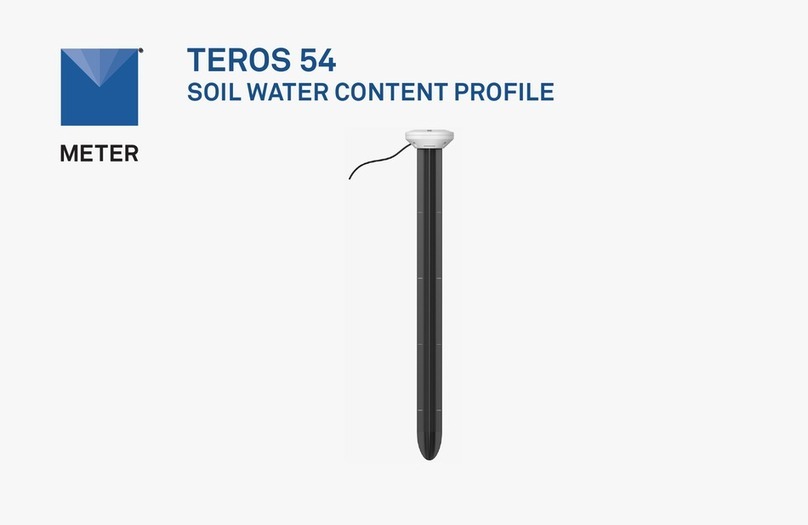
METER
METER TEROS 54 User manual

METER
METER TEROS 12 User manual
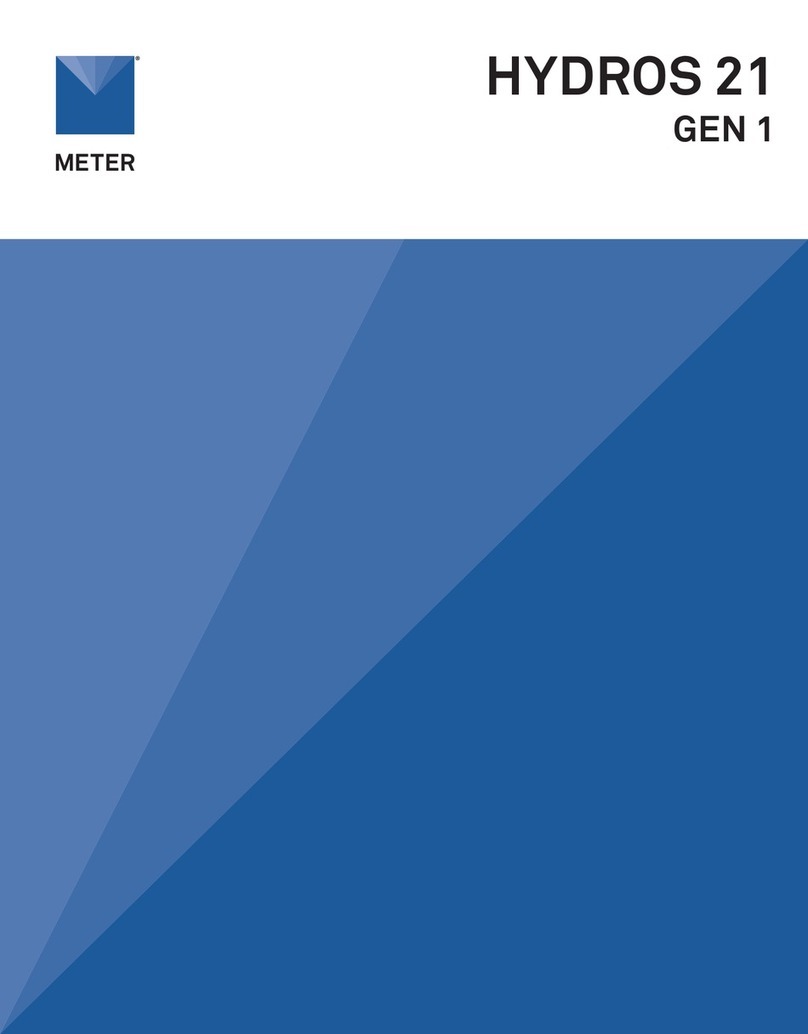
METER
METER HYDROS 21 GEN 1 User manual

METER
METER AROYA User manual
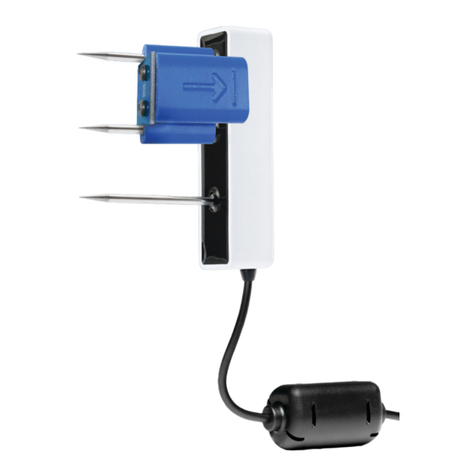
METER
METER TEROS VERIFICATION CLIP User manual
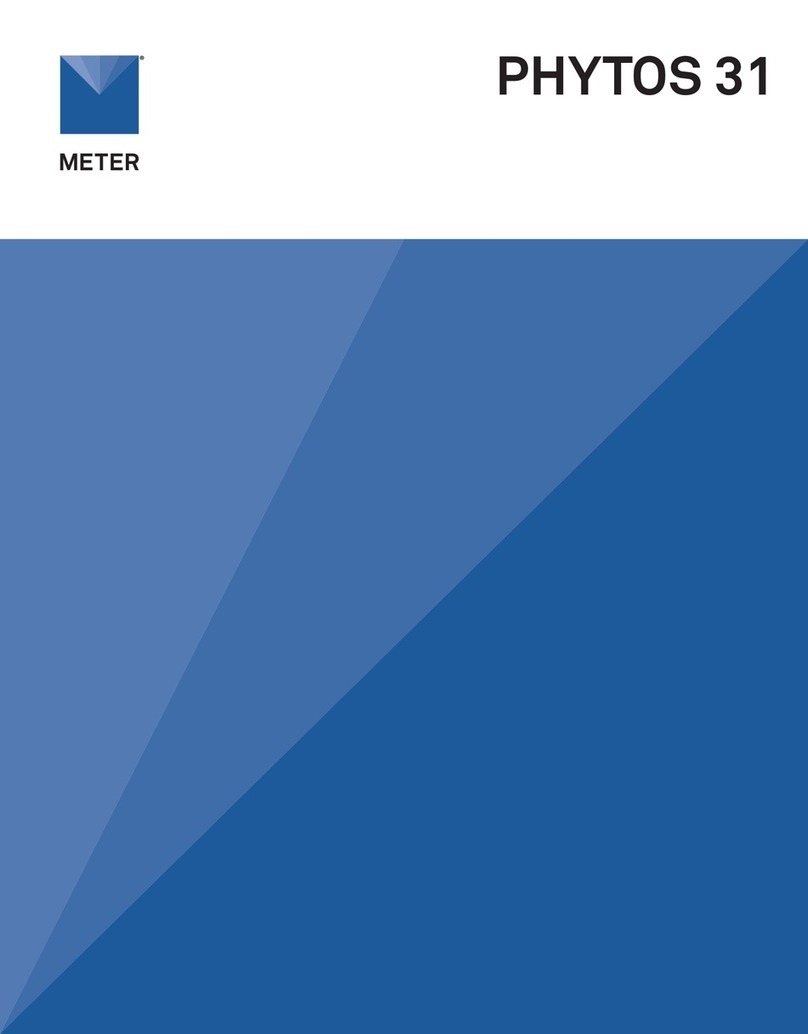
METER
METER PHYTOS 31 User manual
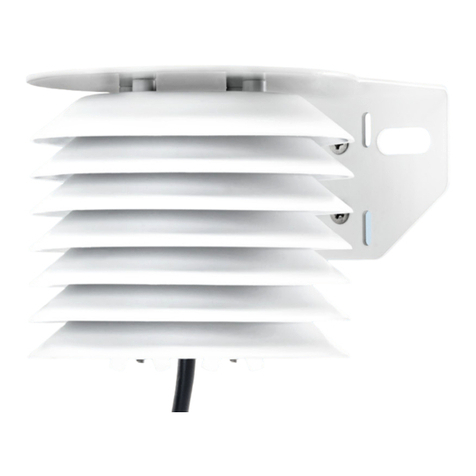
METER
METER ATMOS 14 User manual

METER
METER TEROS 10 User manual
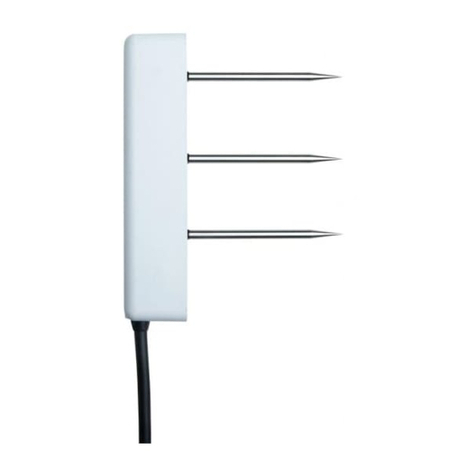
METER
METER TEROS 11 User manual

METER
METER TEROS 11 Assembly Instructions

